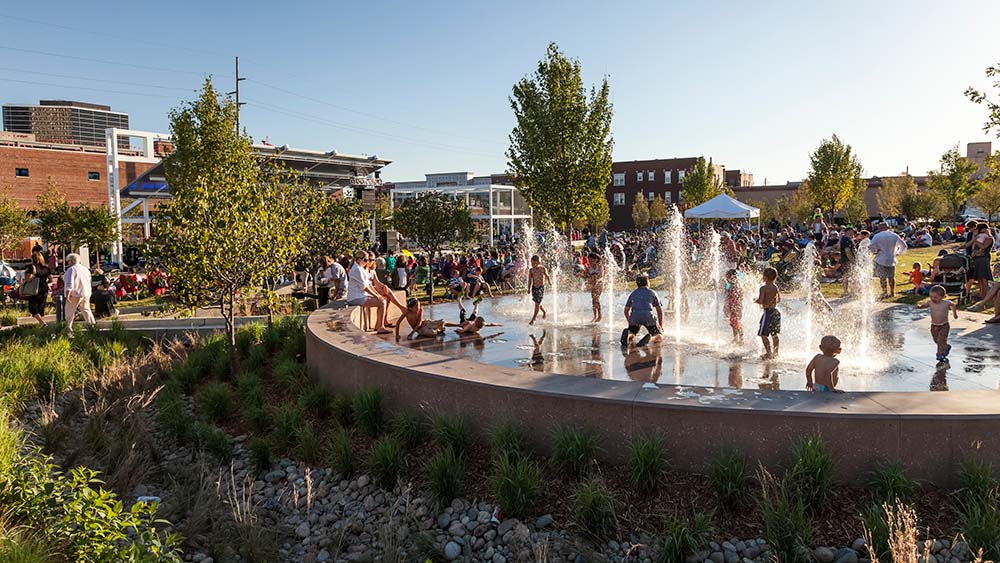
The city of Tulsa, Oklahoma, invested in Guthrie Green, an urban community park, to create a public gathering space with programming that includes music concerts and food truck days. (Courtesy of Visit Tulsa)
Today, more than half of the world’s population lives in a city — a stat that will only trend upward with time, said Chris Fair, CEO of Resonance Consultancy, a global placemaking, branding, and marketing firm for destinations that organizes several in-person and digital WRLDCTY Summits on urban innovation throughout the year. We all have an idea of what makes cities livable, he shared with the online audience during WRLDCTY Summit 02 on April 13: Affordability and availability of housing, job opportunities, safety, and favorable weather are among the top reasons cited by people in two U.S. surveys conducted in 2018 and 2022 by Ipsos, a Resonance research partner.

Chris Fair
But what makes a city lovable?
“I think too often we tend to think about a lot of these things as ‘nice to haves’ as it relates to our cities, whether that’s nightlife or culture or the arts,” Fair said. “But increasingly, we’re seeing that these factors that cause us to love places are actually the factors that are driving cities forward and are really key to their success as a city.”
Here are three of those Resonance Consultancy has identified:
Focus on localization.
“I think one of the great, easiest ways to think about localization is look at how the growth and development and demand for craft beers over the last decade is a symbol of how people want to buy brands and consume things that are small and local,” Fair said. Then, he added, consider how many retail spaces have gone vacant in downtowns in the same span of time. “How do we subdivide those up into smaller spaces?” he asked. One way, he suggested, is to allow for short-term leases that give entrepreneurs an opportunity to thrive while providing local products and services residents and tourists alike crave. The consulting firm also has helped destinations revisit their zoning policies to create more flexibility “for uses and mixes that maybe we haven’t seen yet that will … enable conditions for innovation within this space.”
Turn business districts into socialization districts.
The pandemic prompted a work-from-home revolution resulting in many businesses vacating their downtown office buildings. If these spaces aren’t being used by office workers, how can the public make use of them?
“I think this really requires a very clear programming and activation strategy,” Fair said. “We’ve been working with different downtowns on placemaking and programming strategies that are really about drawing not tourists, but locals, whether that’s from the suburbs or surrounding areas, by creating that programming to give them a reason to visit.” His favorite example of this, he said, is in Tulsa, Oklahoma: In the Tulsa Arts District, the city invested in Guthrie Green, an urban community park, to create a gathering space with corresponding programming, including regularly scheduled music and food truck days. “It’s that kind of programming around a relatively small public space that has been a catalyst for development and demand for retail and residential in that particular district,” he said.
Allow spaces to “rewild.”
“Oftentimes, we’ve looked at our green spaces and designed them to be very formal gardens or lawns,” Fair said. But during the pandemic, he added, many discovered an innate desire for a connection to natural spaces. “Now, as we think about some of the effects of climate change and climate-proofing our riverbanks, waterfronts, and seafronts, we could also think about designing these spaces not only to be more livable and lovable for people but make them more resilient as well to accommodate and anticipate some of the effects of climate change.”
How can a destination make green spaces less formal, more entertaining, and more interactive? By adding such things as boardwalks, trails, and wayfinding, Fair suggested. It’s crucial, he said, to consider “the types of plants we plant, how we design the spaces that create social cohesion, that create that vibrancy and energy of bringing people together in nature that they’re so desperately seeking in our cities today.”
Casey Gale is managing editor of Convene.
